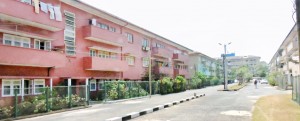News
Revolt in Bamba Flats over new giant condo plan
View(s):
Residents at the Bambalapitiya flats want the condominium plan abandoned within the next week. Pix by Athula Dwvapriya
By Chamal Weerakkody
Dismayed residents of Bambalapitiya Flats are up in arms against the proposed redevelopment of the precinct, panicking over the proposed demolition of their homes and their removal to new quarters.
Individuals have sent letters rejecting the proposed redevelopment project and demanded that the Condominium Management Authority (CMA) abandon the proposal within the next week.
The proposed government plan would see most of the 10.5 acres of land currently occupied by the apartment blocks redeveloped with one acre set apart for a 54-storied condominium to which the residents would be relocated.
The President of the Bambalapitiya Flats Welfare Association (BFWA), N. Ragunanthan, expressed his frustration over the CMA’s strategy to forcibly acquire their property. Mr. Ragunanthan said residents had received a letter on June 26 and a brochure with a floorplan of the proposed condominium, and been given 14 days to respond.
He said the CMA had approached residents on three occasions, in 2012, 2014 and 2016, requesting consent to initiate a redevelopment project. In 2014, the residents had been presented with a proposal to refurbish the existing apartments. Seventeen residents’ representatives had attended the meeting and had requested renovations to the water tank and drainage system, Mr. Ragunanthan said.

The proposed plan
“However, the signatures of the attended representatives were manipulated to draft a paper for the redevelopment proposal,” Mr. Ragunanthan alleged. “The CMA returned on April 1, 2016 with a brochure containing an allocation of one acre for 10 shop-owners and 300 families and rest of the nine- and-a-half acres for a foreign developer.”
Although the residents are frustrated by the CMA’s attitude they are still open to discussion on the redevelopment proposal and want amendments on majority terms and for transactions to occur in fair and transparent manner, Mr. Ragunanthan said.
The Bambalapitiya Flats consists of 17 blocks, 300 apartments, 10 retail outlets and common areas spreading across 10.5 acres. The flats were built in 1956, provided through a rental scheme for government and mercantile executives. In 1977, some of the residents received the deeds to their apartments and the rest were given deeds to their units in 1984. Common areas come under the National Housing Authority.
Most of the original deeds have been transferred by the early residents to their children born and bred at the “Bamba Flats” over the past 60 years. Mithila Malambe, a resident and former president of the BFWA, said the CMA was ignoring the needs of elderly residents with increasing mobility problems in proposing a 54-storey condominium. As well, she said, residents were worried about whether they could afford condominium fees when they were aged and their financial circumstances had changed.

Residents at the Bambalapitiya flats want the condominium plan abandoned within the next week. Pix by Athula Dwvapriya
A condominium manager who wished to stay anonymous said the residents would have to bear higher municipality tax and utilities charges, human resources expenses, fire insurance, sinking fund fees, maintenance fees such as pest control, solid waste management, maintenance and replacement of cabling, wiring or plumbing and upkeep of the property including any outdoor areas – all of which would amount to about Rs. 3 million a month for 300 families and 10 shops.
The CMA says the proposed condominium would have two, three and four-bedroom apartments with eight apartments on each floor, parking spaces, a stand-by generator, five passenger lifts, one service lift, a gymnasium, community centre, swimming pool and many additional features. It says Rs. 100 million would be set aside as a management fund and Rs. 50 million as a sinking fund controlled by the authority.
A CMA brochure states the “developer consortium is led by UTL Group, a Singapore- based consortium with backing from Engineering Projects India Ltd, a Govt. of India company”. Mr. Baratha Mendis, also a former BFWA president, said the CMA should have dealt with residents in a professional manner as most of them had served the country to the utmost in their respective fields.

N. Ragunanthan
Mr. Mendis is head of the Steering Committee set up to advise residents over the proposed condominium. BFWA Vice President Shihab Shaideen, 42, gave a brief history of the Welfare Association, saying it had been established in 1958 with a constitution and a committee elected every year through an Annual General Meeting. Income generated by the community centre was used to pay allowances for six cleaners and to light up common areas. The BFWA paid an annual municipality tax of Rs. 86,000 for the community centre and Rs. 19,000 for the playground.
He dismissed the existence of management corporations from which the CMA claimed to have obtained 17 signatures for redevelopment, saying there was no evidence for the existence of such entities – no AGMs, or minutes or bank accounts or records of meetings held since the establishment of the flats.
Management corporations, according to the Condominium Act, are responsible for the wellbeing of residents and the property. They should collect a maintenance charge from residents and have a fire insurance policy. As there are 17 blocks in the Bambalapitiya Flats there should have been a corporation for each block.
The Sunday Times was told, however, that there have not been any management corporations since the establishment of the flats (and there is no fire insurance policy). The residents had formed a common Welfare Association instead of separate committees.
Mr. Shaideen says that there are no 17 management corporations in existence and that therefore the 17 signatures obtained from people claiming to represent corporations are not valid.

Baratha Mendis
He also claims that as the CMA had been formed many years after the flats were built the Condominiums Law has no authority over the flats. Resident Arul Rajasingham, 68, said in any event, according to the Condominiums Act, representatives of any such management corporations could only represent residents by proxy and would not have any authority to take decisions.
Other residents also expressed deep disquiet.
Prosper Rajanayagam, 72, said the CMA’s objective was to take over the land for a foreign developer, with no guarantee whether residents would be given apartments, and the new apartments could be of substandard construction. M. Sudaharan, 69, feared the CMA or the developer would demand that residents quit the property as soon as the deeds were transferred to them.
He said the authority had neglected to provide a management plan or any other information regarding the proposed condominium.
The CMA Chairman, C.A. Wijayaweera, dismissed these claims, insisting residents would benefit from the proposed project and see their living standards improved.
He said the Flats buildings, in their current condition, required immediate refurbishment according to the residents but the government could not bear this expense and since the owners had been given the deeds to their flats they should have undertaken the necessary renovations.
Given the lack of funds and the need to develop the area the CMA had decided to negotiate with a foreign investor as the better option for the benefit of the occupants of the flats, Mr. Wijayaweera said. He pointed out that the Land Acquisition Act permitted authorities to take over land if necessary for development.
 The Act stipulates that the government can take or acquire private property for “a public purpose” on payment of compensation: the requirement must be for a public purpose. The CMA Chairman said that following the signing of a Memorandum of Understanding with the National Housing Development Authority, residents would receive legal documents of ownership of the new apartments.
The Act stipulates that the government can take or acquire private property for “a public purpose” on payment of compensation: the requirement must be for a public purpose. The CMA Chairman said that following the signing of a Memorandum of Understanding with the National Housing Development Authority, residents would receive legal documents of ownership of the new apartments.
He claimed that a fraction of the flats community was creating a ruckus over the situation and that most residents were willing to consent to redevelopment.
He said the CMA would negotiate only with 17 working corporations regarding the proposal but not with the Welfare Association in accordance with the Condominiums Act which, he said, specified that management corporations were the only authorised body to manage the flats.
Two options will be provided to the residents, Mr. Wijayaweera said: whether to accept the proposed free apartment or accept he monetary value of their current accommodation as determined by a property valuer.

